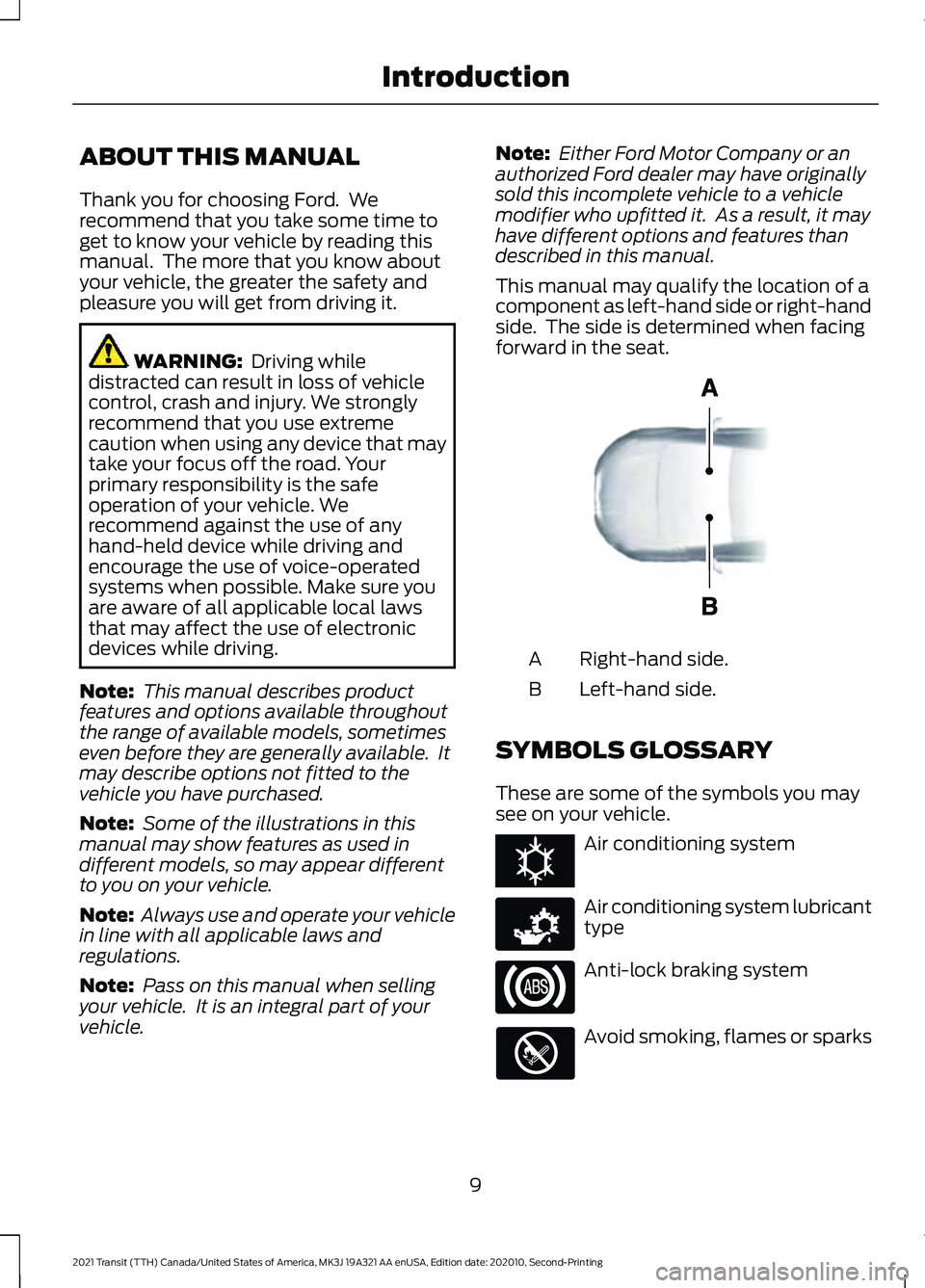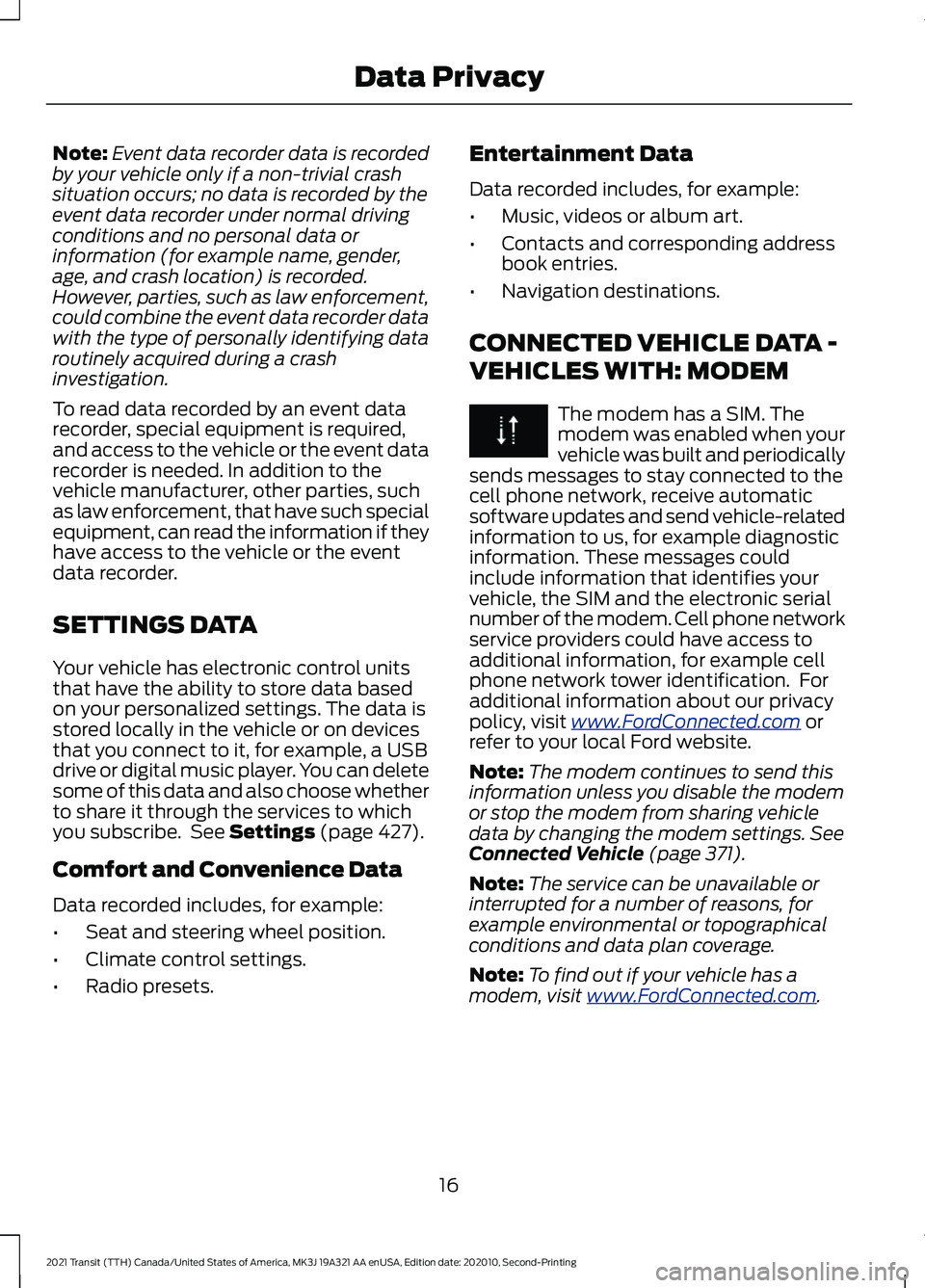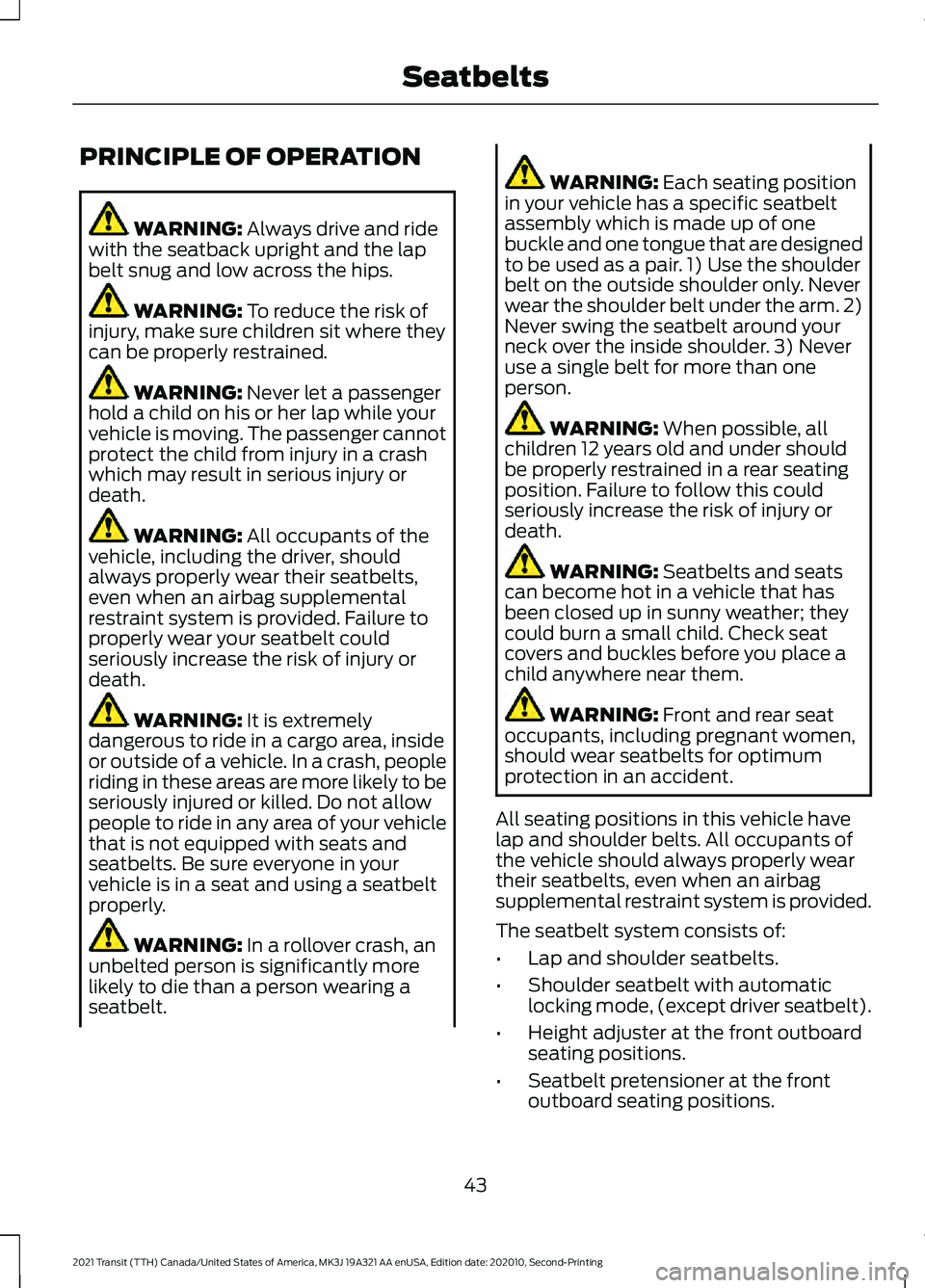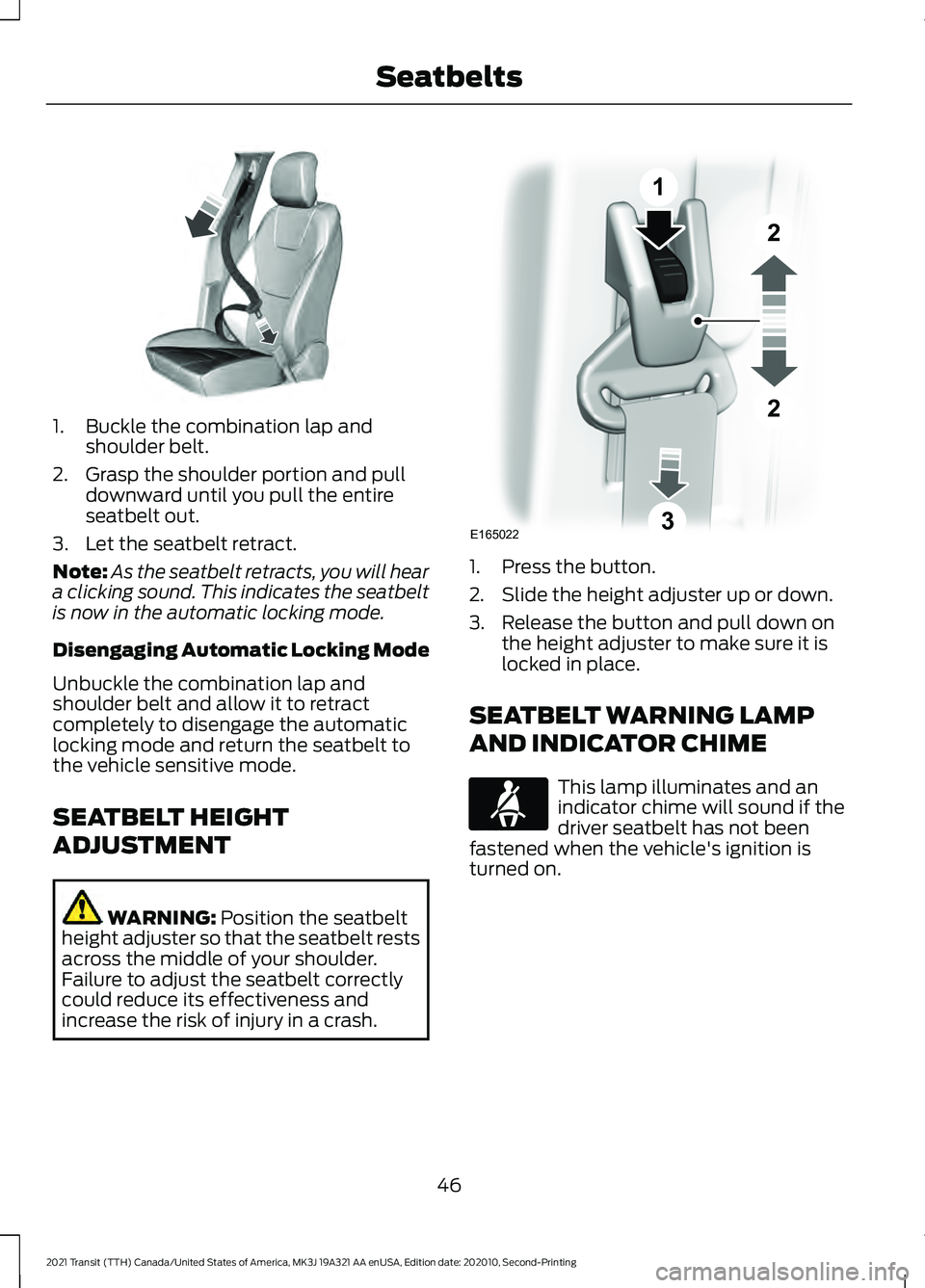ECO mode FORD TRANSIT 2021 Owners Manual
[x] Cancel search | Manufacturer: FORD, Model Year: 2021, Model line: TRANSIT, Model: FORD TRANSIT 2021Pages: 509, PDF Size: 8.21 MB
Page 4 of 509

Introduction
About This Manual
..........................................9
Symbols Glossary ............................................
9
Special Notices ................................................
11
Data Privacy
Data Privacy .....................................................
14
Service Data .....................................................
15
Event Data ........................................................
15
Settings Data ...................................................
16
Connected Vehicle Data - Vehicles With: Modem ...........................................................
16
Mobile Device Data - Vehicles With: SYNC 3 ............................................................
17
Emergency Call System Data ....................
17
Environment
Protecting the Environment .......................
18
Child Safety
General Information ......................................
19
Installing Child Restraints ...........................
21
Booster Seats ..................................................
37
Child Restraint Positioning ........................
39
Child Safety Locks .........................................
41
Seatbelts
Principle of Operation .................................
43
Fastening the Seatbelts .............................
44
Seatbelt Height Adjustment ....................
46
Seatbelt Warning Lamp and Indicator Chime ............................................................
46
Seatbelt Reminder ........................................
47
Child Restraint and Seatbelt Maintenance ...............................................
49
Seatbelt Extensions .....................................
49
Supplementary Restraints System
Principle of Operation .................................
50Driver and Passenger Airbags
....................
51
Side Airbags .....................................................
57
Safety Canopy ™...........................................
58
Crash Sensors and Airbag Indicator ......
59
Airbag Disposal .............................................
60
911 Assist
What Is 911 Assist ...........................................
61
How Does 911 Assist Work ..........................
61
Emergency Call Requirements .................
61
Emergency Call Limitations ......................
62
Keys and Remote Controls
Principle of Operation .................................
63
General Information on Radio Frequencies .................................................
63
Remote Control - Vehicles Without: Passive Anti-Theft System (PATS)
........................................................................\
..
64
Remote Control - Vehicles With: Passive Anti-Theft System (PATS) ....................
65
Remote Control - Vehicles With: Power Sliding Door .................................................
67
Replacing a Lost Key or Remote Control ........................................................................\
..
69
MyKey ™
Principle of Operation .................................
70
MyKey Settings ..............................................
70
Creating a MyKey ............................................
71
Programming a MyKey .................................
71
Clearing All MyKeys .......................................
73
Checking MyKey System Status ..............
74
Using MyKey With Remote Start Systems ........................................................
75
MyKey – Troubleshooting ...........................
75
Doors and Locks
Locking and Unlocking ................................
76
1
2021 Transit (TTH) Canada/United States of America, MK3J 19A321 AA enUSA, Edition date: 202010, Second-Printing Table of Contents
Page 9 of 509

Under Hood Overview - 3.5L Duratec
.......................................................................280
Under Hood Overview - 3.5L Ecoboost™ ........................................................................\
.
281
Engine Oil Dipstick - 3.5L Duratec ........
282
Engine Oil Dipstick - 3.5L Ecoboost™ ........................................................................\
282
Engine Oil Check .........................................
282
Changing the Engine Oil and Oil Filter ........................................................................\
283
Oil Change Indicator Reset .....................
284
Changing the Engine Air Filter ...............
284
Engine Cooling Fan ....................................
285
Engine Coolant Check ..............................
285
Automatic Transmission Fluid Check ........................................................................\
289
Brake Fluid Check ......................................
290
Changing the 12V Battery ........................
290
Adjusting the Headlamps ........................
293
Washer Fluid Check ...................................
294
Fuel Filter .......................................................
294
Checking the Wiper Blades ....................
294
Changing the Front Wiper Blades ........
295
Removing a Headlamp .............................
295
Changing a Bulb .........................................
296
Drive Belt Routing - Vehicles With: Dual Generators .................................................
301
Drive Belt Routing - Vehicles With: Single Generator ...................................................
301
Vehicle Care
Cleaning Products ......................................
302
Cleaning the Exterior .................................
303
Waxing ...........................................................
304
Cleaning the Engine ..................................
304
Cleaning the Windows and Wiper Blades ........................................................................\
305
Cleaning the Interior ..................................
305
Cleaning the Instrument Panel and Instrument Cluster Lens ......................
307
Repairing Minor Paint Damage .............
308Cleaning the Wheels
.................................
308
Vehicle Storage ...........................................
308
Body Styling Kits ..........................................
310
Wheels and Tires
General Information ....................................
311
Tire Sealant and Inflator Kit .....................
312
Tire Care ..........................................................
315
Using Winter Tires ......................................
332
Using Snow Chains ....................................
333
Tire Pressure Monitoring System ..........
334
Changing a Road Wheel ..........................
339
Lug Nuts .........................................................
350
Capacities and Specifications
Engine Specifications - 3.5L Duratec ........................................................................\
352
Engine Specifications - 3.5L Ecoboost™ ........................................................................\
353
Motorcraft Parts - 3.5L Duratec ............
354
Motorcraft Parts - 3.5L Ecoboost™ .....
355
Vehicle Identification Number ...............
356
Transmission Code Designation ............
357
Capacities and Specifications - 3.5L Duratec .......................................................
358
Capacities and Specifications - 3.5L Ecoboost™ ...............................................
363
Bulb Specification Chart .........................
369
Connected Vehicle
What Is a Connected Vehicle ...................
371
Connected Vehicle Requirements .........
371
Connected Vehicle Limitations ...............
371
Connecting the Vehicle to a Mobile Network .......................................................
371
Connecting the Vehicle to a Wi-Fi Network ......................................................
372
Connected Vehicle – Troubleshooting - Vehicles With: Modem ..........................
372
6
2021 Transit (TTH) Canada/United States of America, MK3J 19A321 AA enUSA, Edition date: 202010, Second-Printing Table of Contents
Page 12 of 509

ABOUT THIS MANUAL
Thank you for choosing Ford. We
recommend that you take some time to
get to know your vehicle by reading this
manual. The more that you know about
your vehicle, the greater the safety and
pleasure you will get from driving it.
WARNING: Driving while
distracted can result in loss of vehicle
control, crash and injury. We strongly
recommend that you use extreme
caution when using any device that may
take your focus off the road. Your
primary responsibility is the safe
operation of your vehicle. We
recommend against the use of any
hand-held device while driving and
encourage the use of voice-operated
systems when possible. Make sure you
are aware of all applicable local laws
that may affect the use of electronic
devices while driving.
Note: This manual describes product
features and options available throughout
the range of available models, sometimes
even before they are generally available. It
may describe options not fitted to the
vehicle you have purchased.
Note: Some of the illustrations in this
manual may show features as used in
different models, so may appear different
to you on your vehicle.
Note: Always use and operate your vehicle
in line with all applicable laws and
regulations.
Note: Pass on this manual when selling
your vehicle. It is an integral part of your
vehicle. Note:
Either Ford Motor Company or an
authorized Ford dealer may have originally
sold this incomplete vehicle to a vehicle
modifier who upfitted it. As a result, it may
have different options and features than
described in this manual.
This manual may qualify the location of a
component as left-hand side or right-hand
side. The side is determined when facing
forward in the seat. Right-hand side.
A
Left-hand side.
B
SYMBOLS GLOSSARY
These are some of the symbols you may
see on your vehicle. Air conditioning system
Air conditioning system lubricant
type
Anti-lock braking system
Avoid smoking, flames or sparks
9
2021 Transit (TTH) Canada/United States of America, MK3J 19A321 AA enUSA, Edition date: 202010, Second-Printing IntroductionE154903 E162384 E231157
Page 19 of 509

Note:
Event data recorder data is recorded
by your vehicle only if a non-trivial crash
situation occurs; no data is recorded by the
event data recorder under normal driving
conditions and no personal data or
information (for example name, gender,
age, and crash location) is recorded.
However, parties, such as law enforcement,
could combine the event data recorder data
with the type of personally identifying data
routinely acquired during a crash
investigation.
To read data recorded by an event data
recorder, special equipment is required,
and access to the vehicle or the event data
recorder is needed. In addition to the
vehicle manufacturer, other parties, such
as law enforcement, that have such special
equipment, can read the information if they
have access to the vehicle or the event
data recorder.
SETTINGS DATA
Your vehicle has electronic control units
that have the ability to store data based
on your personalized settings. The data is
stored locally in the vehicle or on devices
that you connect to it, for example, a USB
drive or digital music player. You can delete
some of this data and also choose whether
to share it through the services to which
you subscribe. See Settings (page 427).
Comfort and Convenience Data
Data recorded includes, for example:
• Seat and steering wheel position.
• Climate control settings.
• Radio presets. Entertainment Data
Data recorded includes, for example:
•
Music, videos or album art.
• Contacts and corresponding address
book entries.
• Navigation destinations.
CONNECTED VEHICLE DATA -
VEHICLES WITH: MODEM The modem has a SIM. The
modem was enabled when your
vehicle was built and periodically
sends messages to stay connected to the
cell phone network, receive automatic
software updates and send vehicle-related
information to us, for example diagnostic
information. These messages could
include information that identifies your
vehicle, the SIM and the electronic serial
number of the modem. Cell phone network
service providers could have access to
additional information, for example cell
phone network tower identification. For
additional information about our privacy
policy, visit
www .For dC onne c t e d . c om or
refer to your local Ford website.
Note: The modem continues to send this
information unless you disable the modem
or stop the modem from sharing vehicle
data by changing the modem settings.
See
Connected Vehicle (page 371).
Note: The service can be unavailable or
interrupted for a number of reasons, for
example environmental or topographical
conditions and data plan coverage.
Note: To find out if your vehicle has a
modem, visit
www .For dC onne c t e d . c om .
16
2021 Transit (TTH) Canada/United States of America, MK3J 19A321 AA enUSA, Edition date: 202010, Second-Printing Data Privacy
Page 24 of 509

INSTALLING CHILD
RESTRAINTS
Child Safety Restraint
Use a child safety restraint (sometimes
called an infant carrier, convertible seat,
or toddler seat) for infants, toddlers, or
children weighing 40 lb (18 kg) or less
(generally age four or younger).
Using Lap and Shoulder Belts WARNING:
Do not place a
rearward facing child restraint in front of
an active airbag. Failure to follow this
instruction could result in personal injury
or death. WARNING:
Properly secure
children 12 years old and under in a rear
seating position whenever possible. If
you are unable to properly secure all
children in a rear seating position,
properly secure the largest child on the
front seat. If you must use a forward
facing child restraint on the front seat,
move the seat as far back as possible.
Failure to follow these instructions could
result in personal injury or death. WARNING:
Depending on where
you secure a child restraint, and
depending on the child restraint design,
you may block access to certain seatbelt
buckle assemblies and LATCH lower
anchors, rendering those features
potentially unusable. To avoid risk of
injury, make sure occupants only use
seating positions where they are able to
be properly restrained.
When installing a child safety restraint with
combination lap and shoulder belts:
• Use the correct seatbelt buckle for that
seating position.
• Insert the belt tongue into the correct
buckle until you hear a distinct click
and feel it latch. Make sure the tongue
is securely fastened in the buckle.
• Keep the buckle release button
pointing up and away from the safety
restraint, with the tongue between the
child restraint and the release button,
to prevent accidental unbuckling.
• Place the vehicle seat upon which the
child restraint will be installed in the
upright position.
• Put the seatbelt in the automatic
locking mode. See Step 5. Your vehicle
does not require the use of a locking
clip.
Perform the following steps when
installing the child restraint with
combination lap and shoulder belts:
Note: Although the child restraint
illustrated is a forward facing child restraint,
the steps are the same for installing a
rearward facing child restraint.
21
2021 Transit (TTH) Canada/United States of America, MK3J 19A321 AA enUSA, Edition date: 202010, Second-Printing Child SafetyE142594
Page 25 of 509

1. Position the child safety restraint in a
seat with a combination lap and
shoulder belt. 2. Pull down on the shoulder belt and
then grasp the shoulder belt and lap
belt together. 3.
While holding the shoulder and lap belt
portions together, route the tongue
through the child restraint according
to the child restraint manufacturer's
instructions. Make sure the belt
webbing is not twisted. 4. Insert the belt tongue into the correct
buckle (the buckle closest to the
direction the tongue is coming from)
for that seating position until you hear
a distinct click and feel the latch
engage. Make sure the tongue is
latched securely by pulling on it. 5. To put the retractor in the automatic
locking mode, grasp the shoulder
portion of the belt and pull downward
until all of the belt is pulled out.
Note: The automatic locking mode is
available on the front passenger and rear
seats.
22
2021 Transit (TTH) Canada/United States of America, MK3J 19A321 AA enUSA, Edition date: 202010, Second-Printing Child SafetyE142528 E142529 E142530 E142531 E142875
Page 26 of 509

6. Allow the belt to retract to remove
slack. The belt clicks as it retracts to
indicate it is in the automatic locking
mode.
7. Try to pull the belt out of the retractor to make sure the retractor is in the
automatic locking mode (you should
not be able to pull more belt out). If the
retractor is not locked, unbuckle the
belt and repeat Steps 5 and 6. 8.
Remove remaining slack from the belt.
Force the seat down with extra weight,
for example, by pressing down or
kneeling on the child restraint while
pulling up on the shoulder belt. This is
necessary to remove the remaining
slack that exists once the extra weight
of the child is added to the child
restraint. It also helps to achieve the
correct snugness of the child restraint
to your vehicle. Sometimes, a slight
lean toward the buckle helps to remove
remaining slack from the belt.
9. Attach the tether strap (if the child restraint is equipped). 10. Before placing the child in the seat,
forcibly move the seat forward and
back to make sure the seat is securely
held in place. To check this, grab the
seat at the belt path and attempt to
move it side to side and forward and
back. There should be no more than
1 in (2.5 cm) of movement for correct
installation.
We recommend checking with a NHTSA
Certified Child Passenger Safety
Technician to make certain the child
restraint is correctly installed. In Canada,
check with Transport Canada for referral
to a Child Car Seat Clinic.
Using Lower Anchors and Tethers
for Children (LATCH) WARNING: Do not attach two child
safety restraints to the same anchor. In
a crash, one anchor may not be strong
enough to hold two child safety restraint
attachments and may break, causing
serious injury or death.
23
2021 Transit (TTH) Canada/United States of America, MK3J 19A321 AA enUSA, Edition date: 202010, Second-Printing Child SafetyE142533 E142534
Page 46 of 509

PRINCIPLE OF OPERATION
WARNING: Always drive and ride
with the seatback upright and the lap
belt snug and low across the hips. WARNING:
To reduce the risk of
injury, make sure children sit where they
can be properly restrained. WARNING:
Never let a passenger
hold a child on his or her lap while your
vehicle is moving. The passenger cannot
protect the child from injury in a crash
which may result in serious injury or
death. WARNING:
All occupants of the
vehicle, including the driver, should
always properly wear their seatbelts,
even when an airbag supplemental
restraint system is provided. Failure to
properly wear your seatbelt could
seriously increase the risk of injury or
death. WARNING:
It is extremely
dangerous to ride in a cargo area, inside
or outside of a vehicle. In a crash, people
riding in these areas are more likely to be
seriously injured or killed. Do not allow
people to ride in any area of your vehicle
that is not equipped with seats and
seatbelts. Be sure everyone in your
vehicle is in a seat and using a seatbelt
properly. WARNING:
In a rollover crash, an
unbelted person is significantly more
likely to die than a person wearing a
seatbelt. WARNING:
Each seating position
in your vehicle has a specific seatbelt
assembly which is made up of one
buckle and one tongue that are designed
to be used as a pair. 1) Use the shoulder
belt on the outside shoulder only. Never
wear the shoulder belt under the arm. 2)
Never swing the seatbelt around your
neck over the inside shoulder. 3) Never
use a single belt for more than one
person. WARNING:
When possible, all
children 12 years old and under should
be properly restrained in a rear seating
position. Failure to follow this could
seriously increase the risk of injury or
death. WARNING:
Seatbelts and seats
can become hot in a vehicle that has
been closed up in sunny weather; they
could burn a small child. Check seat
covers and buckles before you place a
child anywhere near them. WARNING:
Front and rear seat
occupants, including pregnant women,
should wear seatbelts for optimum
protection in an accident.
All seating positions in this vehicle have
lap and shoulder belts. All occupants of
the vehicle should always properly wear
their seatbelts, even when an airbag
supplemental restraint system is provided.
The seatbelt system consists of:
• Lap and shoulder seatbelts.
• Shoulder seatbelt with automatic
locking mode, (except driver seatbelt).
• Height adjuster at the front outboard
seating positions.
• Seatbelt pretensioner at the front
outboard seating positions.
43
2021 Transit (TTH) Canada/United States of America, MK3J 19A321 AA enUSA, Edition date: 202010, Second-Printing Seatbelts
Page 48 of 509

Pregnant women should always wear their
seatbelt. The lap belt portion of a
combination lap and shoulder belt should
be positioned low across the hips below
the belly and worn as tight as comfort
allows. The shoulder belt should be
positioned to cross the middle of the
shoulder and the center of the chest.
Seatbelt Locking Modes
WARNING: After a crash, have a
qualified technician check all the
seatbelts to make sure the seatbelts
including the automatic locking retractor
feature for child restraints operate
properly. We recommend replacing any
system that has damage or does not
operate properly. Failure to do so can
result in personal injury or death in the
event of a sudden stop or another crash. WARNING:
You must replace the
seatbelt if the automatic locking
retractor or any other seatbelt function
is not operating correctly. Failure to
replace the seatbelt and retractor
assembly could increase the risk of injury
in a crash.
All seatbelts in your vehicle are
combination lap and shoulder belts. The
driver seatbelt has the first type of locking
mode, and the front outermost passenger
and rear seat seatbelts have both types of
locking modes described as follows: Vehicle Sensitive Mode
This is the normal retractor mode which
allows free shoulder belt length
adjustment to your movements and
locking in response to vehicle movement.
For example, if you brake suddenly or turn
a corner sharply, or your vehicle receives
an impact of approximately
5 mph
(8 km/h) or more, the combination
seatbelts lock to help reduce forward
movement of the driver and passengers.
In addition, the retractor is designed to lock
if you pull the webbing out too quickly. If
the seatbelt retractor locks, slowly lower
the height adjuster to allow the seatbelt
to retract. If the retractor does not unlock,
pull the seatbelt out slowly then feed a
small length of webbing back toward the
stowed position. For rear seatbelts, recline
the rear seat backrest or push the seat
backrest cushion away from the seatbelt.
Feed a small length of webbing back
toward the stowed position.
Automatic Locking Mode
In this mode, the shoulder belt
automatically pre-locks. The seatbelt still
retracts to remove any slack in the
shoulder belt. The automatic locking mode
is not available on the driver seatbelt.
Using Automatic Locking Mode
You should use automatic locking mode
when a child safety seat, except a booster,
is on the front passenger seat or rear seat.
Children 12 years old and under should be
correctly restrained in a rear seating
position whenever possible. See
Child
Safety (page 19).
45
2021 Transit (TTH) Canada/United States of America, MK3J 19A321 AA enUSA, Edition date: 202010, Second-Printing Seatbelts
Page 49 of 509

1. Buckle the combination lap and
shoulder belt.
2. Grasp the shoulder portion and pull downward until you pull the entire
seatbelt out.
3. Let the seatbelt retract.
Note: As the seatbelt retracts, you will hear
a clicking sound. This indicates the seatbelt
is now in the automatic locking mode.
Disengaging Automatic Locking Mode
Unbuckle the combination lap and
shoulder belt and allow it to retract
completely to disengage the automatic
locking mode and return the seatbelt to
the vehicle sensitive mode.
SEATBELT HEIGHT
ADJUSTMENT WARNING: Position the seatbelt
height adjuster so that the seatbelt rests
across the middle of your shoulder.
Failure to adjust the seatbelt correctly
could reduce its effectiveness and
increase the risk of injury in a crash. 1. Press the button.
2. Slide the height adjuster up or down.
3. Release the button and pull down on
the height adjuster to make sure it is
locked in place.
SEATBELT WARNING LAMP
AND INDICATOR CHIME This lamp illuminates and an
indicator chime will sound if the
driver seatbelt has not been
fastened when the vehicle's ignition is
turned on.
46
2021 Transit (TTH) Canada/United States of America, MK3J 19A321 AA enUSA, Edition date: 202010, Second-Printing SeatbeltsE142591 E165022
1
2
2
3 E71880